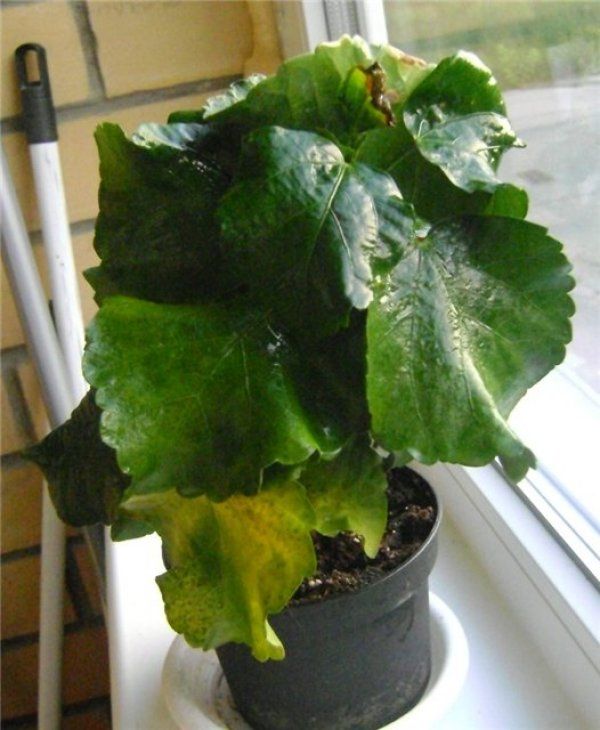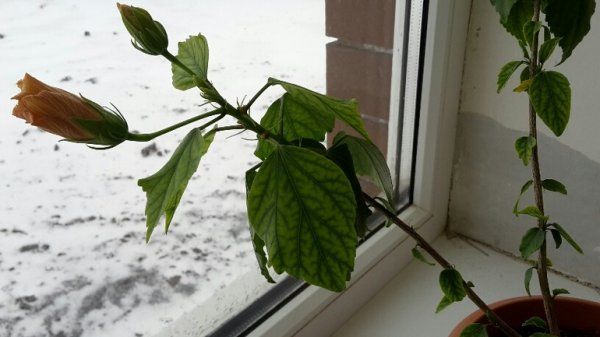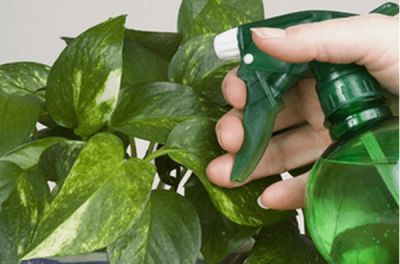
Why do the buds of the Chinese rose fall off. If hibiscus is sick: Chinese rose diseases, treatment methods
Hibiscus or Chinese rose - came to us from the East. This is exotic plant very whimsical and demanding. main feature and the dignity of hibiscus - large bright buds. How nice to see such a miracle on your windowsill.
Unfortunately, this plant shows us its whims. Many are faced with the problem of falling buds. How to cope with this problem, we will try to figure it out and thereby help bring your beautiful rose back to life.
Let's first understand why hibiscus buds fall.
The probable causes of bud drop in Chinese rose can be:
- frequent movement around the apartment or office;
- non-compliance with the irrigation regime (too dry soil);
- lack of light;
- lack of fertilizers and nutrients;
- drafts and low room temperature.
Now let's look at these reasons in more detail and discuss the measures that should be taken.
The whimsicalness of the Chinese rose or hibiscus is most often manifested in the fact that he loves peace and settled way of life. If you have chosen the most favorable place for your flower, do not rearrange it often from place to place. It is better not to disturb this plant once again, in order to avoid any problems.
The most common cause of bud loss is a lack of watering, which can lead to more serious consequences. The root system of the flower may begin to dry out. And, as you know, most often the problem comes from the roots. In order to survive in such conditions, the hibiscus spends all its energy on saving, getting rid of the buds that take the most resources. Review the irrigation regime, supplement it with spraying. In this case, the water must be separated. And when watering - not cold.
Lighting. Lack of light can cause this behavior. Avoiding direct sunlight for a long time, provide the flower with enough diffused warm light. Best of all, hibiscus feels on the windows, which are located on the west side.
With such large flowers, the Chinese rose expends a lot of energy. Therefore, it needs additional fertilizer and top dressing. Choose complex universal fertilizers. Mandatory is the presence of such components as potassium and nitrogen. Avoid fertilizers containing phosphorus. This component, especially in high concentration, will just lead to the fall of the buds of the hibiscus.
There are also temperature limits for the content of hibiscus. The critical low temperature for the normal life of the plant at rest is not less than 15 degrees. In the warm season, and especially during the period of active growth and flowering, a favorable temperature should be 22-24 degrees. Hibiscus does not tolerate drafts. Pay special attention to this.
A prerequisite and guarantee of flowering without problems for hibiscus is compliance with all the rules during dormancy in winter. During this period, you can not feed the plant. Irrigation must be reduced. Water as soon as all the soil is dry. Avoid sudden changes in temperature and conditions of detention.
The most effective way to detect a problem with dropping buds can be pruning. Shorten the length of all stems by 7-10 cm, this will stimulate the hibiscus to bloom again.
Please rate what you read :) (2
ratings, average rating: 9,50
out of 10)
READ ALSO:
How to care for garden hibiscus?
How to plant hibiscus in the garden?
How fast does hibiscus grow?
Hibiscus garden care and reproduction
Hibiscus tree hibernation and planting and care
Can you keep hibiscus at home? Signs
Hibiscus leaves turn yellow, what to do?
Hibiscus buds can fall off due to lack of nutrition.
For the abundant flowering of Hibiscus (Chinese rose), top dressing, good lighting and timely watering are very important.
From fertilizers I use AVA - complex fertilizer. This fertilizer does not contain nitrogen.
It is good because you can bring it into the ground during transplantation, and then not think about top dressing.
Otherwise, hibiscus must be fed every week.
Another important reason for dropping buds is to move the plant to another place.
Hibiscus reacts to the angle of incidence of sunlight. When rearranged or rotated, the plant shows its character - it drops buds. This does not mean that it cannot be touched. You can take it to the bath, wash the leaves. But then return it to its original position.
Make a light mark on the pot, this will help to place the flower correctly.
My Hibiscus are on the south balcony.
If I forget about top dressing, then the flowers become smaller and may fall off.
My photos

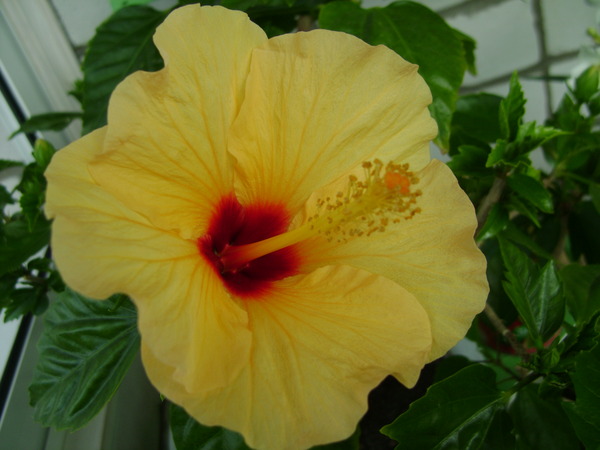
hibiscus does not like drafts
Maybe the plant is standing in a cold draft. Or the water for irrigation is too cold. Or a newly purchased plant was transported in inappropriate conditions. Or the plant was transplanted when the buds had already formed. Or the difference between day and night temperatures is too great. Store the ready-to-flower plant in a very mild climate at 18°C and at least 60% humidity. Water more often and reduce the fertilizer concentration. As soon as the buds appear on the plant, do not move it even for watering.
Maybe the temperature in the room is too high and the air is too dry. He may not have enough water. Never spray flowering plants, as even small drops of water have a bad effect on the petals. Spots appear on them, and they quickly fall off. Possible pests: spider mites, scale insects. Then it will be necessary to carry out the treatment with drugs against pests: aktara, etc. etc.
hibiscus is a very capricious plant ... it reacts to any change by dropping buds.
I've noticed for myself the main thing - the lack of lighting. He also loves a lot of moisture (both watering and spraying).
I spit on these falling buds one day, shaped the hibiscus into a tree and placed it in a dark corner of the room... the tree looks gorgeous!
In vivo hibiscus grows in the tropics of Africa, India and China. We know him by the name "Chinese rose". unpretentious flower with beautiful decorative leaves fell in love with flower growers. Now it is grown both in gardens and in apartments. There are varieties of hibiscus, the flowers of which are used for brewing tea, coloring syrups and treating a variety of diseases.
Hibiscus diseases
Diseases caused by non-compliance with agricultural technology
Hibiscus is a fairly hardy plant and can forgive some care mistakes. But, despite this, agricultural technology in the cultivation of the "Chinese rose" is very important and its non-compliance leads to pest infestation and disease development.  Chlorosis - this is a disease in which the green parts of the plant change their color to yellow, lemon or whitish due to a decrease in the amount of chlorophyll. This disease is non-infectious and infectious.
Chlorosis - this is a disease in which the green parts of the plant change their color to yellow, lemon or whitish due to a decrease in the amount of chlorophyll. This disease is non-infectious and infectious.
- Non-infectious chlorosis appears with violations in the nutrition of the plant: lack or excess of nitrogen, magnesium, potassium, iron. Potassium and magnesium are inherently competing elements. An excess of one leads to a deficiency of the other. Potassium is needed flowering plant. With its deficiency, the plant does not bloom, or the flowers are slightly colored, and the branches are thin. Magnesium deficiency leads to chlorosis. Iron deficiency also causes yellowing and leaf fall. In order to prevent this, the water for watering the plant must be defended and iron chelate added to it.
- infectious chlorosis caused by viruses, fungi and pests. Dust removal, timely fertilization, transplanting and pest control will help to avoid these diseases.
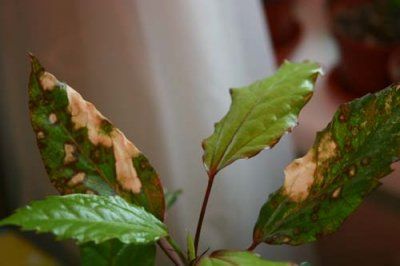 Sunburn. Direct sunlight, falling on a plant that has not yet adapted, partially destroys chloroform in them, as a result of which the leaves become covered with white spots of burns. This temporary phenomenon is observed if the flower was moved from a greenhouse or a place with a lack of consecration to the bright sun. The hibiscus quickly adapts to changes in light and new leaves will grow back normally. To avoid the loss of decorativeness and not to injure the plant, it must be accustomed to change by taking it out into the sun for an hour a day, gradually increasing the length of stay.
Sunburn. Direct sunlight, falling on a plant that has not yet adapted, partially destroys chloroform in them, as a result of which the leaves become covered with white spots of burns. This temporary phenomenon is observed if the flower was moved from a greenhouse or a place with a lack of consecration to the bright sun. The hibiscus quickly adapts to changes in light and new leaves will grow back normally. To avoid the loss of decorativeness and not to injure the plant, it must be accustomed to change by taking it out into the sun for an hour a day, gradually increasing the length of stay.
Diseases caused by pests
 Greenhouse and tobacco whiteflies. When the plant is affected, its leaves turn yellow and become covered with sticky secretions. Pale yellow larvae or adult white-winged insects can be seen on the underside of the leaves. To combat and prevent the disease, the plant is treated with potassium soap solutions or Biotlin, Fufanon, Aktara, etc.
Greenhouse and tobacco whiteflies. When the plant is affected, its leaves turn yellow and become covered with sticky secretions. Pale yellow larvae or adult white-winged insects can be seen on the underside of the leaves. To combat and prevent the disease, the plant is treated with potassium soap solutions or Biotlin, Fufanon, Aktara, etc.
Spider mite (web on hibiscus). In the affected plant, the leaves fade and become covered with yellowish specks. Subsequently, extensive dried areas appear on them. The underside of the leaves is covered with a web in which the pest lives. To combat and prevent the disease, it is necessary to wash the leaves with soap or mineral oil, and also treat with Lightning, Fitoverm, Akarin, etc.
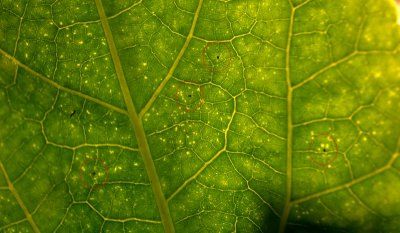 Aphid. Aphids are attracted to the young leaves and buds of the plant. When damaged, they deform and become sticky. For the prevention and control of the disease, the plant is treated with soapy water, tobacco dust, Biotlin, Akarin, Decis, etc.
Aphid. Aphids are attracted to the young leaves and buds of the plant. When damaged, they deform and become sticky. For the prevention and control of the disease, the plant is treated with soapy water, tobacco dust, Biotlin, Akarin, Decis, etc.
Worms. White waxy discharge appears on the petioles and in the axils of the leaves. To combat the disease, the plant is sprayed with Aktofit or treated with mineral oils.
Shields and false shields. Brownish or pale brown tubercles appear on the stems of the plant. With a small damage to the plant, the pests are removed mechanically, and the affected areas of the plant are wiped with kerosene or mineral oil. With severe damage, the plant is best treated with an insecticide.
Bacterial spotting. The edges of the leaves of the affected plant are covered with rotting yellow spots. For the prevention and treatment of the disease, the plant is systematically examined and treated with Fundazol, Cumulus, Euparen, etc.
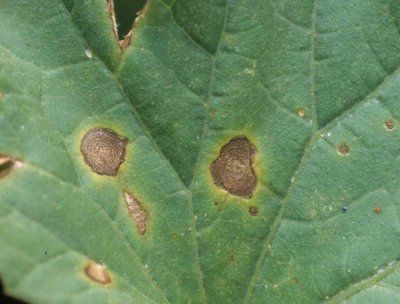 Brown rot. Most often affects young plants and seedlings. In the affected plant, the stems turn brown and thin at the very base. To prevent the disease, cuttings and seedlings are treated with Rovral. Seedlings should be planted shallow, spraying thoroughly after planting.
Brown rot. Most often affects young plants and seedlings. In the affected plant, the stems turn brown and thin at the very base. To prevent the disease, cuttings and seedlings are treated with Rovral. Seedlings should be planted shallow, spraying thoroughly after planting.
Vascular wilt. Called by fungi. In the affected plant, the branches and trunk rapidly dry out, sometimes not having time to lose foliage. To treat the disease in the affected plant, the damaged parts are cut out and treated with an antifungal drug.
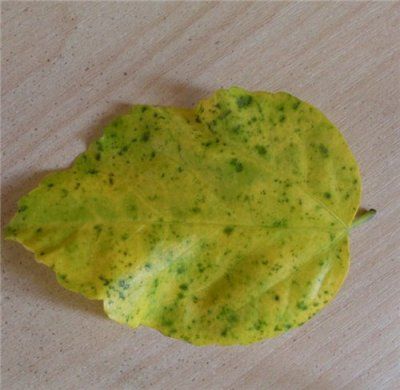 Midge gall midge. In affected plants, the buds turn yellow and fall off without even blooming. Midges midges lay their eggs in tiny hibiscus buds, so to prevent the disease, yellowed buds are collected, preventing them from falling, and the soil under the flower is treated with a preparation from soil pests.
Midge gall midge. In affected plants, the buds turn yellow and fall off without even blooming. Midges midges lay their eggs in tiny hibiscus buds, so to prevent the disease, yellowed buds are collected, preventing them from falling, and the soil under the flower is treated with a preparation from soil pests.
Symptoms of diseases
Hibiscus leaves turn yellow. The most likely causes of the disease are pest damage (aphids, spider mites), diseases of the root system, insufficient air humidity or leaf chlorosis. The causes of chlorosis is the excess of the content of chlorine and calcium in the water for irrigation with a lack of nitrogen and iron. Water for watering the plant should be defended and iron chelate added.
Hibiscus leaves are falling. Stress, lack of moisture. It is necessary to create peace for the plant and spray.
Indoor hibiscus - leaves turn yellow and fall off. Stress, insufficient humidity, draft, waterlogging of the roots in winter. It is necessary to create peace for the plant, spray it, making sure that the kidney does not turn into a liquid mess.
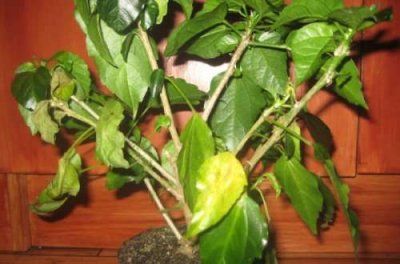 Why do hibiscus leaves curl?. The plant is affected by aphids. Needs to be treated for pests.
Why do hibiscus leaves curl?. The plant is affected by aphids. Needs to be treated for pests.
Hibiscus leaves wither. Nutrient deficiencies. It is necessary to feed the plant with nitrogen and phosphorus preparations.
Withering hibiscus. The plant is too hot. It is necessary to reduce the temperature in the room, shade, spray.
Why do hibiscus drop buds? The plant is too hot. The soil lacks potassium fertilizers. The buds are affected by the midge gall midge.
What to do if hibiscus dies?
If your Chinese rose is sick, do not despair, it may be possible to resuscitate it. Hibiscus is unpretentious, and it is quite possible to treat it at home.
Video: ROSE FLOWERING. FIRST WAVE
At the moment, many preparations have been developed for pest control, they can be purchased at specialized stores or you can use folk methods by treating the plant with a solution of soap, tincture of tobacco or pepper.Folk remedies for hibiscus pest control
Pepper tincture (from aphids, ticks) - Dry pepper is poured with water in a ratio of 1: 2 and boiled for an hour, then insisted and filtered. For spraying a plant, 10 g of the drug is diluted in one liter of water and soap. Soap should be taken about 5g per liter.
Tobacco tincture (from aphids, thrips, ticks) - 1 kg of tobacco dust or tobacco is boiled in 10 liters of water for two hours. Insist for two days and filter. Before use, the concentrate is diluted in 10 liters of water with 50 g of soap.
Soap solution. To prepare the preparation, 200 g of potassium soap is diluted in 10 liters of water.
Mustard tincture (for ticks, aphids) - 50g of mustard is boiled in a liter of water and insisted. Before use, the concentrate is diluted in 20 liters of water.
Agricultural technology is of great importance in the maintenance of hibiscus: soil acidity, heat and light conditions, air and soil humidity. Create comfort for the flower: do not move, treat pests, loosen the soil and water once a week and gradually the hibiscus will grow new leaves.
A photo
